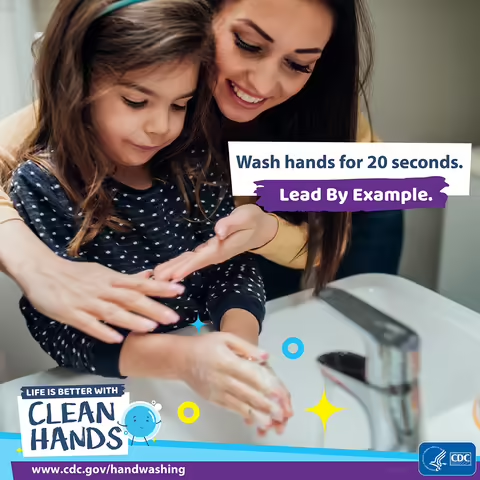DECATUR, Ill. — When it comes to handwashing, don’t splash and dash. Take the time to wash your hands thoroughly with soap and water to stay healthy and stop germs from spreading to others.
“Handwashing is our No. 1 defense against germs,” said Caitlin Mellendorf, an Illinois Extension Nutrition & Wellness Educator serving DeWitt, Macon and Piatt counties.
Washing with soap and water reduces bacteria on your hands by 92% compared to washing with water, which only removes 77% of bacteria, according to a 2011 study published in the International Journal of Environmental Research and Public Health.
The Centers for Disease Control and Prevention recommends these steps to washing hands: wet hands with water, apply soap, rub hands all over – including fingers, palms, back of hands and wrists – for at least 15 seconds, rinse hands with water, and dry with a clean towel or paper towel. See a demonstration of why handwashing is important at go.illinois.edu/handwashing.
Friction and running water lift germs off your hands and wash them down the drain. Germs can hide in jewelry and hard-to-clean crevices, including knuckles, between fingers, folds of the palm, and under the nails, so focus on scrubbing those areas.
It is important to wash hands after using the bathroom, after sneezing or coughing, after changing diapers or after taking out the trash. Also, wash your hands before tasks such as touching food, before using medical syringes or before changing contact lenses.
“We touch a lot of surfaces throughout the day – phones, computers, door handles – and so we want to wash our hands later to defend ourselves,” Mellendorf said. However, since you can’t wash your hands after every encounter, try not to touch your face, eyes, nose and mouth to avoid introducing germs to your system.
“Your first defense is going to be handwashing with soap and water,” Mellendorf said. “But when a sink is not available, an alcohol-based hand sanitizer, with at least 60% alcohol, can be used to kill the germs on your hands.”
Only use hand sanitizer if your hands are not visibly dirty. Wash them instead. Dirt, grease, food particles and other surface contaminants reduce how effective hand sanitizers are. Use enough hand sanitizer to cover your hands fully before it dries. This should take about 20 seconds.
For additional information about hand hygiene, visit the Centers for Disease Control and Prevention website.
The University of Illinois Extension Nutrition & Wellness program encourages individuals, families and communities to live healthier through online and in-person skill sharing. Learn about managing diabetes, safely preserving foods, being food-safe at home and making healthier choices when shopping, cooking and meal planning. Find us on Facebook or Twitter.
30-second PSA – Make handwashing a healthy habit everywhere you go. Handwashing is your first line of defense against illness and can reduce bacteria on your hands by 92%. Wash your hands with soap and water for at least 20 seconds, especially after going to the bathroom; before, during, and after preparing food; and before eating. If soap and water aren’t available, use a hand sanitizer that has at least 60% alcohol. A message from University of Illinois Extension.
Source: Caitlin Mellendorf, MS, RD, University of Illinois Extension, Nutrition & Wellness Educator serving DeWitt, Macon and Piatt Counties, (217) 877-6042.
News Writer: Emily Steele, Publicity Promotion Associate
Contact
Caitlin Mellendorf
Extension Educator, Nutrition and Wellness
Macon Extension Office
3351 N. President Howard Brown Blvd., Decatur, IL 62521
(217) 877-6042
chuth2@illinois.edu
